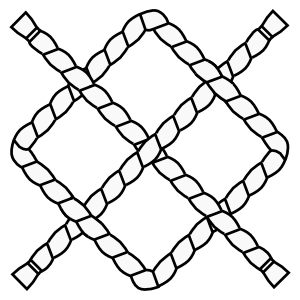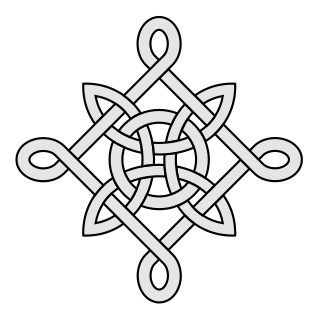 W
WA heraldic knot is a knot, unknot, or design incorporating a knot used in European heraldry. While a given knot can be used on more than one family's achievement of arms, the family on whose coat the knot originated usually gives its name to the said knot. These knots can be used to charge shields and crests, but can also be used in badges or as standalone symbols of the families for whom they are named. The simplest of these patterns, the Bowen knot, is often referred to as the heraldic knot in symbolism and art outside of heraldry.
 W
WThe Bourchier knot is a variety of heraldic knot. It was used as a heraldic badge by the Bourchier family, whose earliest prominent ancestor in England was John de Bourchier, a Judge of the Common Pleas, seated at Stanstead Hall in the parish of Halstead, Essex. He was the father of Robert Bourchier, 1st Baron Bourchier (d.1349), Lord Chancellor of England. The various branches of his descendants held the titles Baron Bourchier, Count of Eu, Viscount Bourchier, Earl of Essex, Baron Berners, Baron FitzWarin and Earl of Bath. The knot should perhaps have been called the "FitzWarin knot" as according to Boutell (1864) the device was first used by the FitzWarin family, whose heir was the Bourchier family.
 W
WThe Bowen knot is not a true knot, but is rather a heraldic knot, sometimes used as a heraldic charge. It is named after the Welshman James Bowen and is also called true lover's knot. It consists of a rope in the form of a continuous loop laid out as an upright square shape with loops at each of the four corners. Since the rope is not actually knotted, it would in topological terms be considered an unknot.
 W
WThe Harrington knot is a decorative heraldic knot, the badge of the Harrington family. It is in essence identical to the fret.
 W
WThe Heneage knot is a decorative heraldic knot, the badge of the Heneage family of Lincolnshire, England. It was awarded to Sir Thomas Heneage by Queen Elizabeth I in 1594.
 W
WThe Hinckaert knot, a type of decorative unknot, is a heraldic knot used primarily in Dutch heraldry. It is most notable for its appearance on the Hinckaert family heraldic badge, where a semi-angular form is used as canting arms, a common practice with heraldic badges.
 W
WThe Hungerford or Hastings knot is a heraldic knot used as an heraldic badge in English heraldry by the Hungerford and Hastings families. The binding together of a Hungerford sickle and a Peverell garb (wheatsheaf) with the Hungerford knot commemorates the marriage between the Hungerfords and the Peverells in the early 15th century.
 W
WThe Lacy or de Lacy knot is a decorative heraldic knot, the badge of the de Lacy family. It features in the crest of the borough of Burnley and heraldic badge of Kirklees.
 W
WThe Savoy knot, a type of decorative knot, is a heraldic knot used primarily in Italian heraldry. It is most notable for its appearance on the heraldic badge of the House of Savoy, where it is accompanied by the motto Stringe ma non costringe, "It tightens, but does not constrain". The Cavendish knot is an identical heraldic knot. In shape, the Savoy knot is comparable to a figure eight.
 W
WThe Wake knot or Ormond knot is an English heraldic knot used historically as an heraldic badge by the Wake family, lords of the manor of Bourne in Lincolnshire and also by the Butler family, Earls of Ormond.